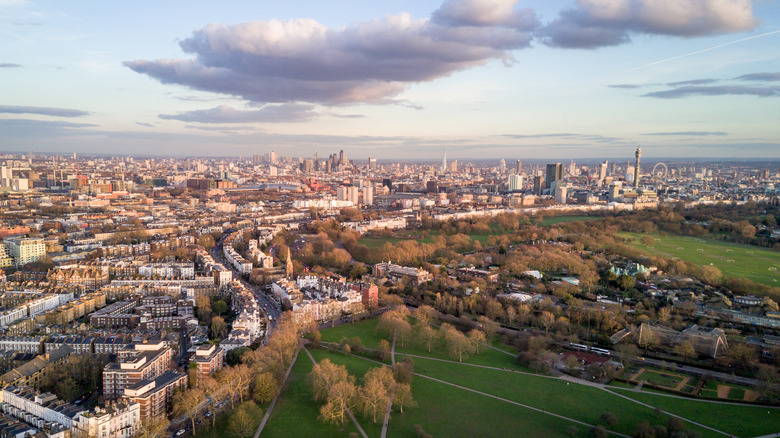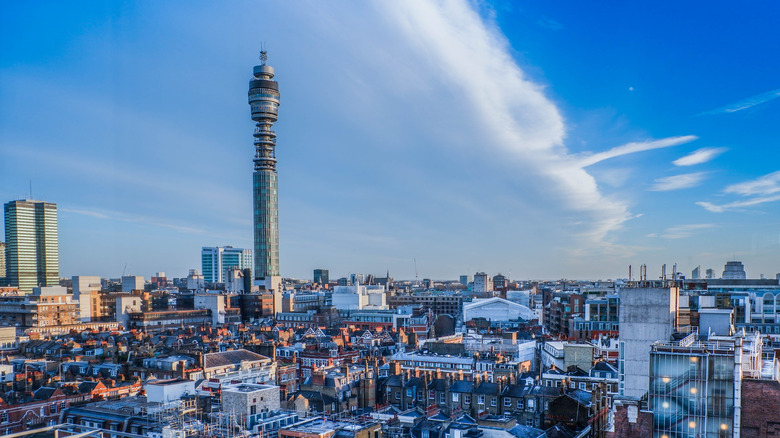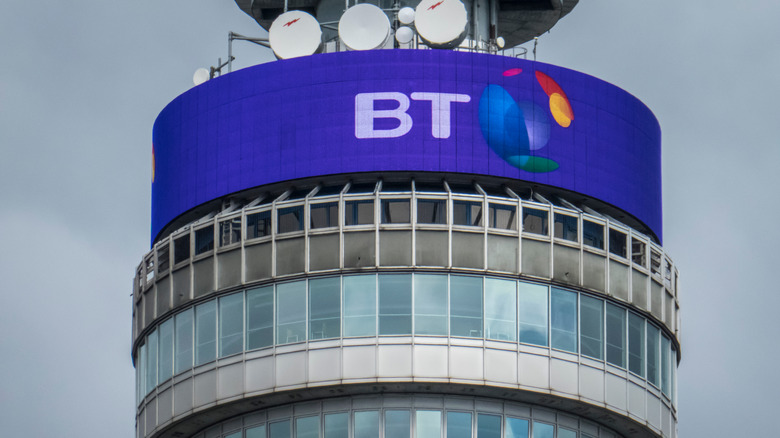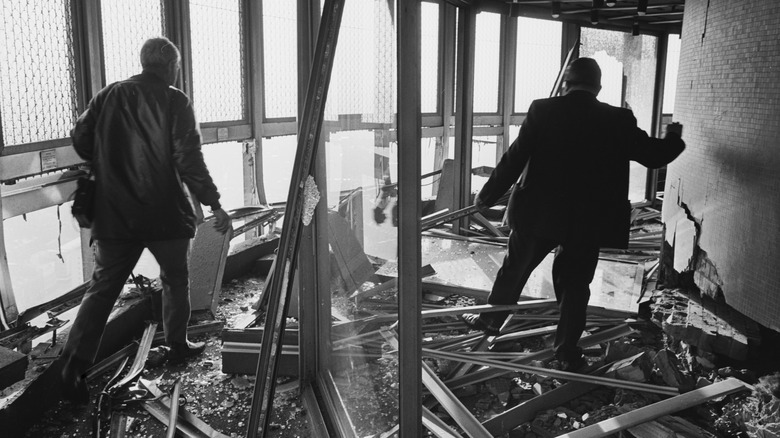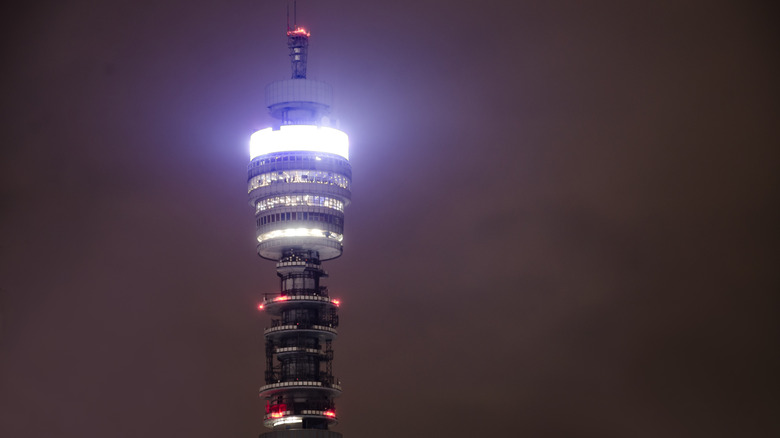The Secret History Behind A Very Visible Tower In The Middle Of London
A tower was considered a classified secret location for decades, even though it was plainly visible to all who walked by it, according to Fact Fiend. Located in Camden, London, this building is more than 600 feet tall — you can't miss it. It's even considered a landmark, per Britannica.
Fact Fiend reports that the building — called the BT Tower — had an essential use: if there was ever a nuclear attack on Britain, the necessary equipment to handle that event would be inside the building. According to Urban 75, the BT Tower was designed to be round for just that reason — engineers believe that rounded buildings survive nuclear warfare better than square buildings due to the way rounded buildings were the only ones to survive nuclear blasts in Hiroshima and Nagasaki. The building is quite tall because it's used for telecommunications, and needed to be high up in the air to beam calls across all of London.
My London reports that at one time, the building was designated as secret through the "Official Secrets Act." If you gave up the location or any information about the BT Tower, you would be considered a traitor under United Kingdom law.
Don't photograph this building, don't talk about it
Per Urban 75, even taking a snapshot of the building could land you in hot water with the law. This only changed decades later in 1993, per Fact Fiend, when a member of Parliament announced that the building in fact existed, citing parliamentary privilege in order to reveal the building without becoming a traitor.
According to My London, the BT Tower was constructed in 1965 and held the title of the tallest building in the United Kingdom for 15 years after it was completed. It was previously called the Post Office Tower and the London Telecom Tower before the name was changed to the British Telecom Tower, or BT Tower for short (via Britannica).
My London reports that this building was allegedly always kept off of official Ordnance Survey maps — but that's not quite true. To start, the BT Tower has always been included on tourist maps that are popular with visitors.
Not-so-secret restaurant
Although the building has been cloaked in secrecy, some of the myths around it have been debunked. Contrary to popular belief, the BT Tower was actually included in the 1971 and 1981 Ordnance Survey, though it was labeled as the Post Office Tower at that time (via Charles Close Society).
Incredibly, the super-mysterious BT Tower decided to operate a restaurant headed by Sir Billy Butlin and Tony Benn (via Urban 75). In May 1966, the eatery opened to the public, and 1.5 million people dined there in just the first year. The restaurant on the 34th story brought in millions of people each year to dine in the rotating restaurant, enjoying the view of London. Per YouTube, the restaurant made a full 360-degree rotation about every 23 minutes, so diners could take in the sites and scenery throughout their meal. Today, the restaurant is no longer open, according to Visit London.
Inside the BT Tower
Historic London Tours reports that the BT Tower had a huge impact on London communications when it was built. It could broadcast 40 television channels, instead of the three channels previously available. And it could handle 150,000 phone calls at a time. Since these communication devices, mainly microwave dishes, are so sensitive, the building is designed to sway as little as possible. Unlike other highrise buildings that are built to sway for safety reasons, the BT Tower will never move more than ten inches, even in 95 mile-per-hour winds.
Today, inside the BT Tower, the first 16 floors are dedicated to utility services, reports Urban 75. That includes ventilation, refrigeration, power, and radio units. Just above the 16th floor, there is an open room full of equipment for TV, radio, and data transmissions, including microwave antennas and dish equipment. This section of the building houses an uninterruptable power source for the building so that in case of an emergency, communications would remain stable.
Above that are six more floors containing kitchens, elevator motors, water tanks, and other technical suites (via Urban 75). On the very top of the building is the London Weather Centre radar mast, which towers 40 feet over the building.
Explosives on the 31st floor
My London reports that in 1971 the building was attacked. Someone left a bomb in the men's restroom, which went off at 4:30 in the morning, stunning nearby residents and damaging cars and other buildings. Luckily, no one was in the BT Tower restaurant at the time. But the bomb left massive holes in the building, and the restaurant sustained severe damage. No one was hurt, but the building's popularity waned after the event; the restaurant has never reopened to the public.
Urban 75 reports that the blast took out the entire 31st floor and the damage took two years to repair. Per Historic London Tours, a man from the Kilburn Battalion of the Irish Republican Army, or the IRA, tried to claim responsibility, but so did a group of anarchists called the Angry Brigade. No one was ever charged for the crime, adding another layer of mystery to the BT Tower (via Urban 75).
Despite being a landmark for years, it was still illegal to talk about the BT Tower (via Historic London Tours). One journalist, Duncan Campbell, found this out the hard way. In 1978, he went to trial for claims that he had been gathering information about the BT Tower. Even during his trial, the BT Tower was referred to as "Location 23."
Can you visit the BT Tower?
Urban 75 reports that in 2009, the restaurant planned a reopening, but by the next year, these plans were scrapped. According to Historic London Tours, the restaurant was once again set to open in 2012 to coincide with the London Olympic Games — but the plans fell through. Beyond those unexplained cancelations, the building has been susceptible to technological glitches. For example, in 2010, the tower's public display spent an entire weekend flashing a Windows 7 error message, reports The Register.
Visit London reports that this landmark is no longer open for tourists to visit, but in June 2018, the BT Tower hosted guests overnight in a one-time-only opportunity (via Luxury Travel Advisor). However, for those who are dying to catch a glimpse inside, there is hope. Each year, the BT Tower opens for one day in September. But act fast — you'll need to enter a lottery program if you want to try and visit.
